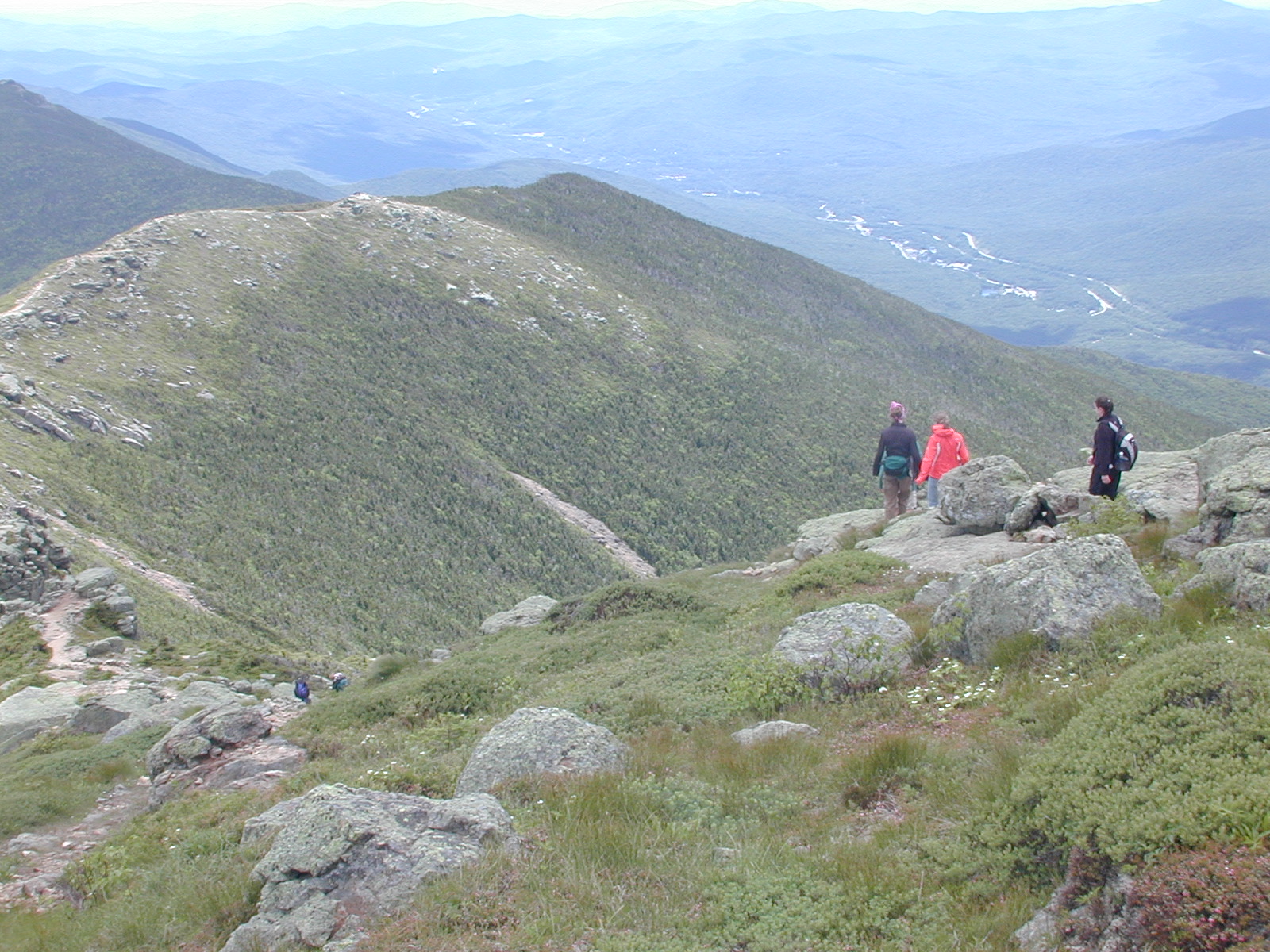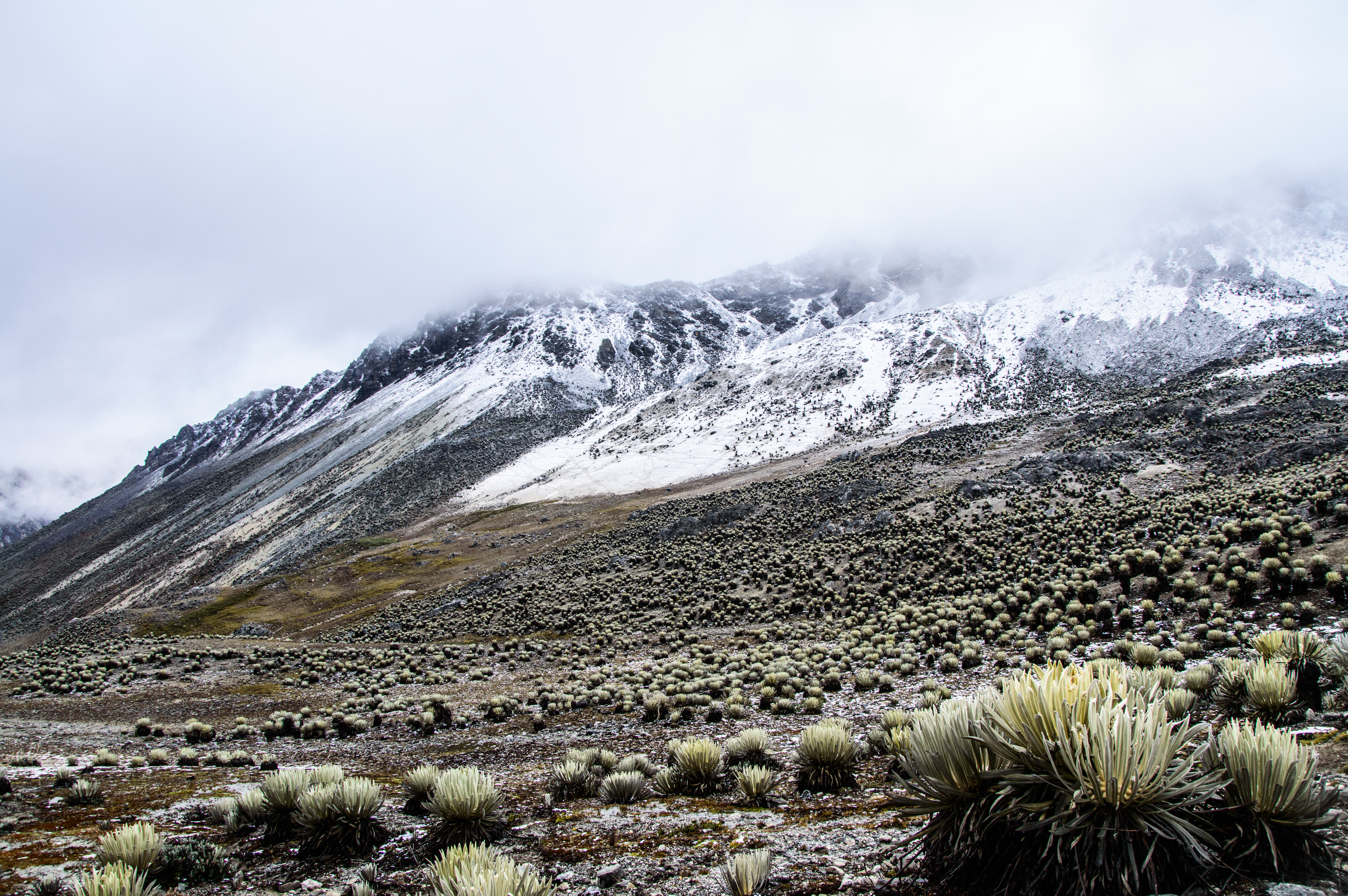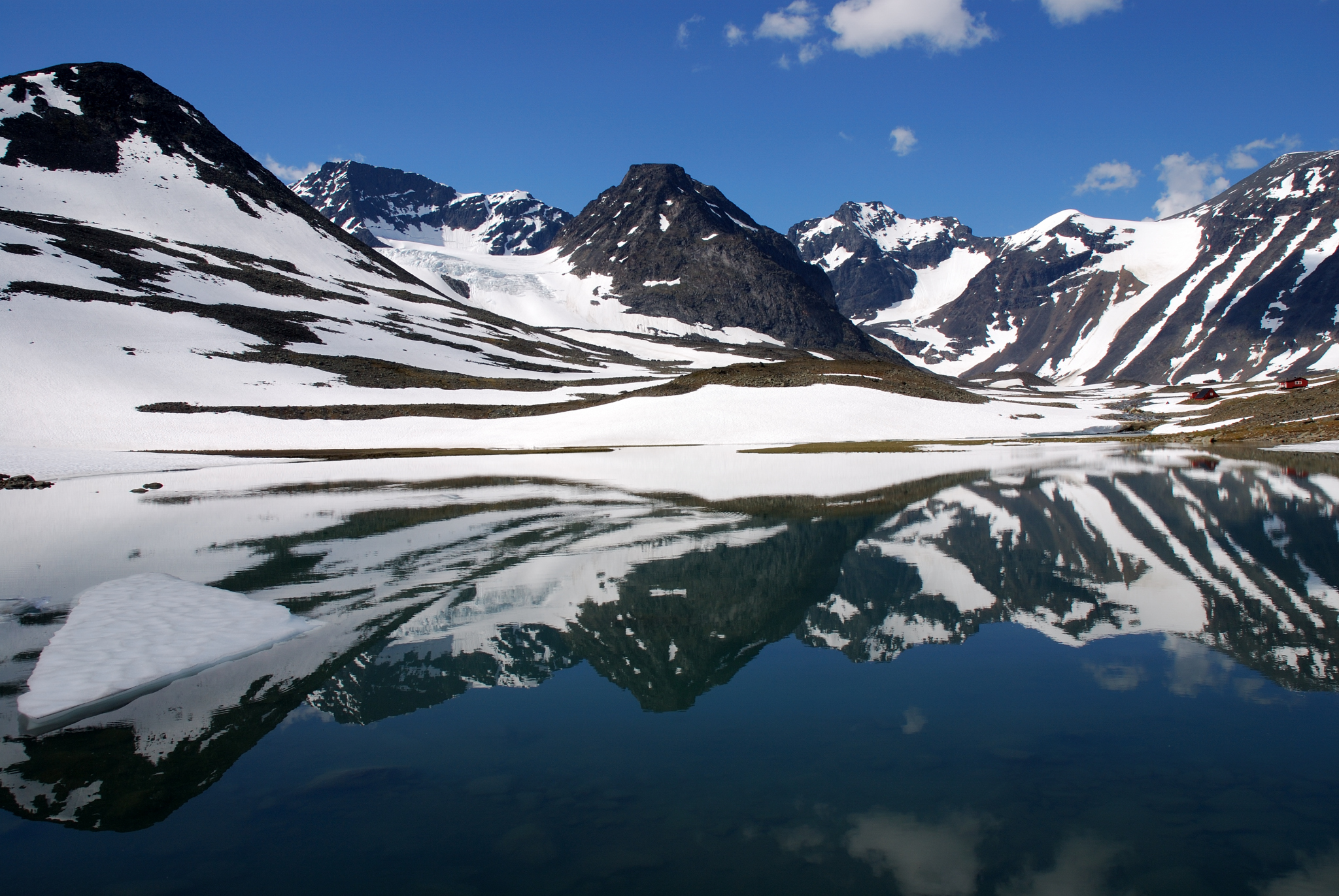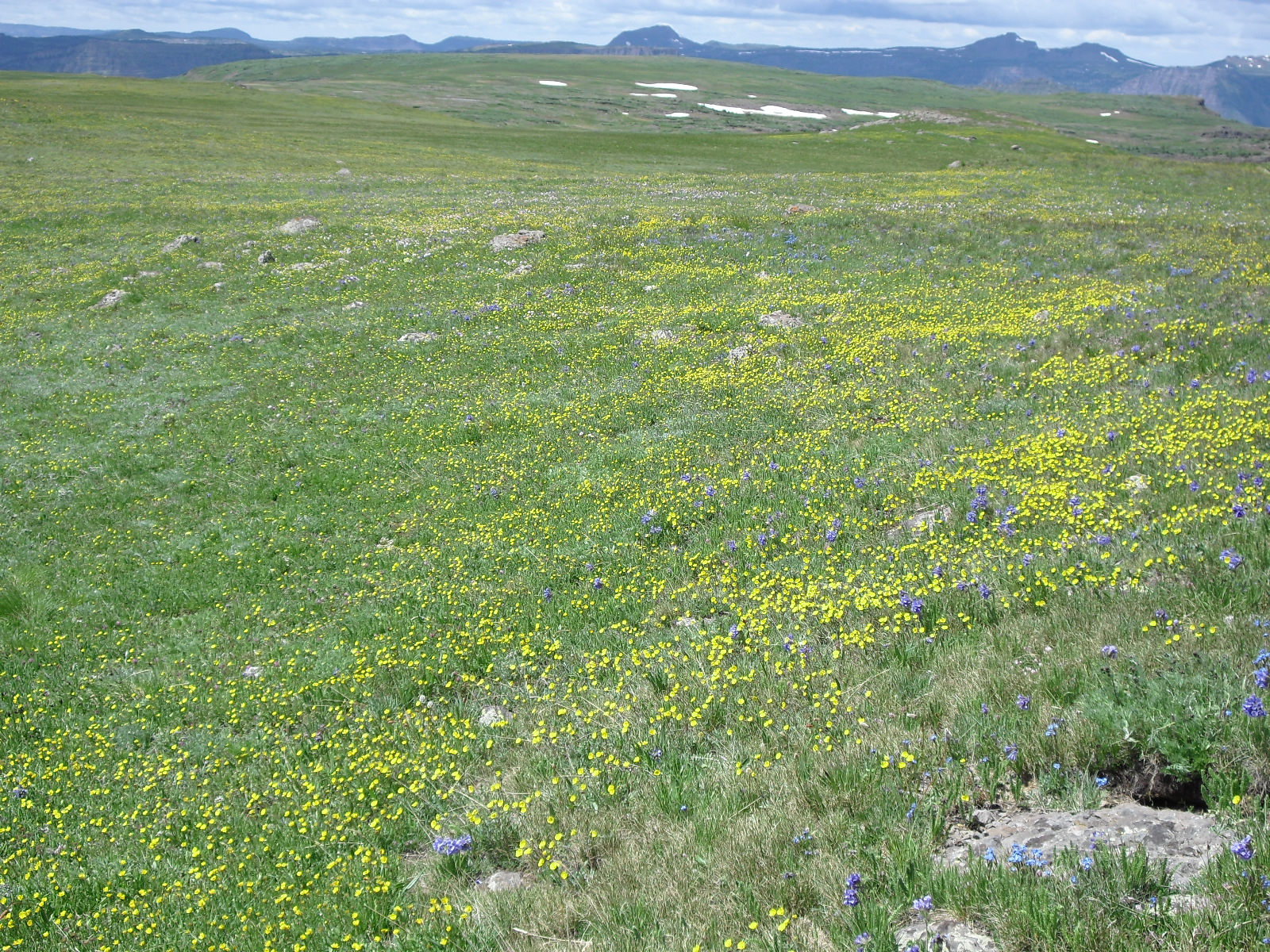Alpine tundra on:
[Wikipedia]
[Google]
[Amazon]

 Alpine tundra is a type of
Alpine tundra is a type of

 There have been several attempts at quantifying what constitutes an alpine climate.
Climatologist Wladimir Köppen demonstrated a relationship between the Arctic and Antarctic tree lines and the 10 °C summer isotherm; i.e., places where the average temperature in the warmest calendar month of the year is below 10 °C cannot support forests. See
There have been several attempts at quantifying what constitutes an alpine climate.
Climatologist Wladimir Köppen demonstrated a relationship between the Arctic and Antarctic tree lines and the 10 °C summer isotherm; i.e., places where the average temperature in the warmest calendar month of the year is below 10 °C cannot support forests. See
 Since the habitat of alpine vegetation is subject to intense radiation, wind, cold, snow, and ice, it grows close to the ground and consists mainly of
Since the habitat of alpine vegetation is subject to intense radiation, wind, cold, snow, and ice, it grows close to the ground and consists mainly of  Plants have adapted to the harsh alpine environment. Cushion plants, looking like ground-hugging clumps of moss, escape the strong winds blowing a few inches above them. Many flowering plants of the alpine tundra have dense hairs on stems and leaves to provide wind protection or red-colored pigments capable of converting the sun's light rays into heat. Some plants take two or more years to form flower buds, which survive the winter below the surface and then open and produce fruit with seeds in the few weeks of summer.
Alpine areas are unique because of the severity and complexity of their environmental conditions. Very small changes in
Plants have adapted to the harsh alpine environment. Cushion plants, looking like ground-hugging clumps of moss, escape the strong winds blowing a few inches above them. Many flowering plants of the alpine tundra have dense hairs on stems and leaves to provide wind protection or red-colored pigments capable of converting the sun's light rays into heat. Some plants take two or more years to form flower buds, which survive the winter below the surface and then open and produce fruit with seeds in the few weeks of summer.
Alpine areas are unique because of the severity and complexity of their environmental conditions. Very small changes in  Alpine meadows form where sediments from the weathering of rocks has produced soils well-developed enough to support grasses and sedges. Non-flowering lichens cling to rocks and soil. Their enclosed algal cells can photosynthesize at any temperature above , and the outer fungal layers can absorb more than their own weight in water. The adaptations for survival of drying winds and cold may make tundra vegetation seem very hardy, but in some respects the tundra is very fragile. Repeated footsteps often destroy tundra plants, allowing exposed soil to blow away; recovery may take hundreds of years.
Alpine meadows form where sediments from the weathering of rocks has produced soils well-developed enough to support grasses and sedges. Non-flowering lichens cling to rocks and soil. Their enclosed algal cells can photosynthesize at any temperature above , and the outer fungal layers can absorb more than their own weight in water. The adaptations for survival of drying winds and cold may make tundra vegetation seem very hardy, but in some respects the tundra is very fragile. Repeated footsteps often destroy tundra plants, allowing exposed soil to blow away; recovery may take hundreds of years.
 Because alpine tundra is located in various widely separated regions of the Earth, there is no animal species common to all areas of alpine tundra. Some animals of alpine tundra environments include the kea, marmot, mountain goat,
Because alpine tundra is located in various widely separated regions of the Earth, there is no animal species common to all areas of alpine tundra. Some animals of alpine tundra environments include the kea, marmot, mountain goat,
 Alpine tundra is a type of
Alpine tundra is a type of natural region
A natural region (landscape unit) is a basic geographic unit. Usually, it is a region which is distinguished by its common natural features of geography, geology, and climate.
From the ecological point of view, the naturally occurring flora an ...
or biome that does not contain trees because it is at high elevation
The elevation of a geographic location is its height above or below a fixed reference point, most commonly a reference geoid, a mathematical model of the Earth's sea level as an equipotential gravitational surface (see Geodetic datum § ...
, with an associated harsh climate. As the latitude of a location approaches the poles, the threshold elevation for alpine tundra gets lower until it reaches sea level, and alpine tundra merges with polar tundra.
The high elevation causes an adverse climate, which is too cold and windy to support tree growth. Alpine tundra transitions to sub-alpine forests below the tree line; stunted forests occurring at the forest-tundra ecotone
An ecotone is a transition area between two biological communities, where two communities meet and integrate. It may be narrow or wide, and it may be local (the zone between a field and forest) or regional (the transition between forest and gras ...
are known as '' Krummholz''. With increasing elevation it ends at the snow line where snow and ice persist through summer.
Alpine tundra occurs in mountains worldwide. The flora of the alpine tundra is characterized by dwarf shrubs close to the ground. The cold climate of the alpine tundra is caused by adiabatic cooling of air, and is similar to polar climate.
Geography
Alpine tundra occurs at high enough altitude at anylatitude
In geography, latitude is a coordinate that specifies the north– south position of a point on the surface of the Earth or another celestial body. Latitude is given as an angle that ranges from –90° at the south pole to 90° at the north ...
. Portions of montane grasslands and shrublands ecoregions worldwide include alpine tundra. Large regions of alpine tundra occur in the North American Cordillera and parts of the northern Appalachian Mountains
The Appalachian Mountains, often called the Appalachians, (french: Appalaches), are a system of mountains in eastern to northeastern North America. The Appalachians first formed roughly 480 million years ago during the Ordovician Period. The ...
in North America, the Alps
The Alps () ; german: Alpen ; it, Alpi ; rm, Alps ; sl, Alpe . are the highest and most extensive mountain range system that lies entirely in Europe, stretching approximately across seven Alpine countries (from west to east): France, Sw ...
and Pyrenees
The Pyrenees (; es, Pirineos ; french: Pyrénées ; ca, Pirineu ; eu, Pirinioak ; oc, Pirenèus ; an, Pirineus) is a mountain range straddling the border of France and Spain. It extends nearly from its union with the Cantabrian Mountains to ...
of Europe, the Himalaya
The Himalayas, or Himalaya (; ; ), is a mountain range in Asia, separating the plains of the Indian subcontinent from the Tibetan Plateau. The range has some of the planet's highest peaks, including the very highest, Mount Everest. Over 10 ...
and Karakoram of Asia, the Andes
The Andes, Andes Mountains or Andean Mountains (; ) are the longest continental mountain range in the world, forming a continuous highland along the western edge of South America. The range is long, wide (widest between 18°S – 20°S ...
of South America, the Eastern Rift mountains of Africa, and the South Island of New Zealand.
Alpine tundra occupies high-mountain summits, slopes, and ridges above timberline. Aspect plays a role as well; the treeline often occurs at higher elevations on warmer equator-facing slopes. Because the alpine zone is present only on mountains, much of the landscape is rugged and broken, with rocky, snowcapped peaks, cliffs, and talus slopes, but also contains areas of gently rolling to almost flat topography.
Averaging over many locations and local microclimate
A microclimate (or micro-climate) is a local set of atmospheric conditions that differ from those in the surrounding areas, often with a slight difference but sometimes with a substantial one. The term may refer to areas as small as a few squ ...
s, the treeline rises when moving 1 degree south from 70 to 50°N, and per degree from 50 to 30°N. Between 30°N and 20°S, the treeline is roughly constant, between .
Climate

Alpine climate
Alpine climate is the typical weather (climate) for elevations above the tree line, where trees fail to grow due to cold. This climate is also referred to as a mountain climate or highland climate.
Definition
There are multiple definitions o ...
is the average weather (climate
Climate is the long-term weather pattern in an area, typically averaged over 30 years. More rigorously, it is the mean and variability of meteorological variables over a time spanning from months to millions of years. Some of the meteorologi ...
) for the alpine tundra. The climate becomes colder at high elevation
The elevation of a geographic location is its height above or below a fixed reference point, most commonly a reference geoid, a mathematical model of the Earth's sea level as an equipotential gravitational surface (see Geodetic datum § ...
s—this characteristic is described by the lapse rate of air: air tends to get colder as it rises, since it expands. The dry adiabatic lapse rate is 10 °C per km (5.5 °F per 1000 ft) of elevation or altitude. Therefore, moving up on a mountain is roughly equivalent to moving 80 kilometers (45 miles or 0.75° of latitude) towards the pole. This relationship is only approximate, however, since local factors such as proximity to ocean
The ocean (also the sea or the world ocean) is the body of salt water that covers approximately 70.8% of the surface of Earth and contains 97% of Earth's water. An ocean can also refer to any of the large bodies of water into which the wor ...
s can drastically modify the climate.
In the alpine tundra, trees cannot tolerate the environmental conditions (usually cold temperatures, extreme snowpack, or associated lack of available moisture). Typical high-elevation growing seasons range from 45 to 90 days, with average summer temperatures near . Growing season temperatures frequently fall below freezing, and frost occurs throughout the growing season in many areas. Precipitation
In meteorology, precipitation is any product of the condensation of atmospheric water vapor that falls under gravitational pull from clouds. The main forms of precipitation include drizzle, rain, sleet, snow, ice pellets, graupel and hail. ...
occurs mainly as winter snow, but soil water availability is highly variable with season, location, and topography. For example, snowfield
A snow field, snowfield or neve is an accumulation of permanent snow and ice, typically found above the snow line, normally in mountainous and glacial terrain.
Glaciers originate in snowfields. The lower end of a glacier is usually free from s ...
s commonly accumulate on the lee sides of ridges while ridgelines may remain nearly snow free due to redistribution by wind. Some alpine habitats may be up to 70% snow free in winter. High wind
Wind is the natural movement of air or other gases relative to a planet's surface. Winds occur on a range of scales, from thunderstorm flows lasting tens of minutes, to local breezes generated by heating of land surfaces and lasting a few ...
s are common in alpine ecosystems, and can cause significant soil erosion and be physically and physiologically detrimental to plants. Also, wind coupled with high solar radiation
Solar irradiance is the power per unit area ( surface power density) received from the Sun in the form of electromagnetic radiation in the wavelength range of the measuring instrument.
Solar irradiance is measured in watts per square metre ...
can promote extremely high rates of evaporation
Evaporation is a type of vaporization that occurs on the surface of a liquid as it changes into the gas phase. High concentration of the evaporating substance in the surrounding gas significantly slows down evaporation, such as when h ...
and transpiration
Transpiration is the process of water movement through a plant and its evaporation from aerial parts, such as leaves, stems and flowers. Water is necessary for plants but only a small amount of water taken up by the roots is used for growth ...
.
Quantifying the climate
 There have been several attempts at quantifying what constitutes an alpine climate.
Climatologist Wladimir Köppen demonstrated a relationship between the Arctic and Antarctic tree lines and the 10 °C summer isotherm; i.e., places where the average temperature in the warmest calendar month of the year is below 10 °C cannot support forests. See
There have been several attempts at quantifying what constitutes an alpine climate.
Climatologist Wladimir Köppen demonstrated a relationship between the Arctic and Antarctic tree lines and the 10 °C summer isotherm; i.e., places where the average temperature in the warmest calendar month of the year is below 10 °C cannot support forests. See Köppen climate classification
The Köppen climate classification is one of the most widely used climate classification systems. It was first published by German-Russian climatologist Wladimir Köppen (1846–1940) in 1884, with several later modifications by Köppen, nota ...
for more information.
Otto Nordenskjöld theorized that winter conditions also play a role: His formula is ''W'' = 9 − 0.1 ''C'', where ''W'' is the average temperature in the warmest month and ''C'' the average of the coldest month, both in degrees Celsius (this would mean, for example, that if a particular location had an average temperature of in its coldest month, the warmest month would need to average or higher for trees to be able to survive there).
In 1947, Holdridge improved on these schemes, by defining biotemperature
The Holdridge life zones system is a global bioclimatic scheme for the classification of land areas. It was first published by Leslie Holdridge in 1947, and updated in 1967. It is a relatively simple system based on few empirical data, giving ob ...
: the mean annual temperature, where all temperatures below 0 °C are treated as 0 °C (because it makes no difference to plant life, being dormant). If the mean biotemperature is between , Holdridge quantifies the climate as alpine.
Flora
perennial grass
A perennial plant or simply perennial is a plant that lives more than two years. The term ('' per-'' + '' -ennial'', "through the years") is often used to differentiate a plant from shorter-lived annuals and biennials. The term is also widel ...
es, sedges, and forbs. Perennial herbs (including grasses, sedges, and low woody or semi-woody shrubs) dominate the alpine landscape; they have much more root
In vascular plants, the roots are the organs of a plant that are modified to provide anchorage for the plant and take in water and nutrients into the plant body, which allows plants to grow taller and faster. They are most often below the su ...
and rhizome biomass than that of shoots, leaves, and flowers. The roots and rhizomes not only function in water and nutrient absorption but also play a very important role in over-winter carbohydrate storage. Annual plants are rare in this ecosystem and usually are only a few inches tall, with weak root systems. Other common plant life-forms include prostrate shrubs; tussock-forming graminoids; cushion plants; and cryptogams, such as bryophytes and lichens.
Relative to lower elevation areas in the same region, alpine regions have a high rate of endemism
Endemism is the state of a species being found in a single defined geographic location, such as an island, state, nation, country or other defined zone; organisms that are indigenous to a place are not endemic to it if they are also found els ...
and a high diversity of plant species. This taxonomic diversity can be attributed to geographical isolation, climate change
In common usage, climate change describes global warming—the ongoing increase in global average temperature—and its effects on Earth's climate system. Climate change in a broader sense also includes previous long-term changes to ...
s, glaciation
A glacial period (alternatively glacial or glaciation) is an interval of time (thousands of years) within an ice age that is marked by colder temperatures and glacier advances. Interglacials, on the other hand, are periods of warmer climate bet ...
, microhabitat differentiation, and different histories of migration or evolution
Evolution is change in the heritable characteristics of biological populations over successive generations. These characteristics are the expressions of genes, which are passed on from parent to offspring during reproduction. Variation ...
or both. These phenomena contribute to plant diversity by introducing new flora and favoring adaptations, both of new species and the dispersal of pre-existing species.
 Plants have adapted to the harsh alpine environment. Cushion plants, looking like ground-hugging clumps of moss, escape the strong winds blowing a few inches above them. Many flowering plants of the alpine tundra have dense hairs on stems and leaves to provide wind protection or red-colored pigments capable of converting the sun's light rays into heat. Some plants take two or more years to form flower buds, which survive the winter below the surface and then open and produce fruit with seeds in the few weeks of summer.
Alpine areas are unique because of the severity and complexity of their environmental conditions. Very small changes in
Plants have adapted to the harsh alpine environment. Cushion plants, looking like ground-hugging clumps of moss, escape the strong winds blowing a few inches above them. Many flowering plants of the alpine tundra have dense hairs on stems and leaves to provide wind protection or red-colored pigments capable of converting the sun's light rays into heat. Some plants take two or more years to form flower buds, which survive the winter below the surface and then open and produce fruit with seeds in the few weeks of summer.
Alpine areas are unique because of the severity and complexity of their environmental conditions. Very small changes in topography
Topography is the study of the forms and features of land surfaces. The topography of an area may refer to the land forms and features themselves, or a description or depiction in maps.
Topography is a field of geoscience and planetary sc ...
– as small as 1 foot (0.3 m) or less – may mean the difference between a windswept area or an area of snow accumulation, changing the potential productivity and plant community drastically. Between these extremes of drought
A drought is defined as drier than normal conditions.Douville, H., K. Raghavan, J. Renwick, R.P. Allan, P.A. Arias, M. Barlow, R. Cerezo-Mota, A. Cherchi, T.Y. Gan, J. Gergis, D. Jiang, A. Khan, W. Pokam Mba, D. Rosenfeld, J. Tierney, an ...
versus saturation, several intermediate environments may exist all within a few yards of each other, depending on topography, substrate, and climate. Alpine vegetation generally occurs in a mosaic of small patches with widely differing environmental conditions. Vegetation types vary from cushion and rosette plants on the ridges and in the rock crannies; to herbaceous and grassy vegetation along the slopes; dwarf shrubs with grasses and forbs below the melting snowdrifts; and sedges, grasses, low shrubs, and mosses in the bogs and along the brooks.
 Alpine meadows form where sediments from the weathering of rocks has produced soils well-developed enough to support grasses and sedges. Non-flowering lichens cling to rocks and soil. Their enclosed algal cells can photosynthesize at any temperature above , and the outer fungal layers can absorb more than their own weight in water. The adaptations for survival of drying winds and cold may make tundra vegetation seem very hardy, but in some respects the tundra is very fragile. Repeated footsteps often destroy tundra plants, allowing exposed soil to blow away; recovery may take hundreds of years.
Alpine meadows form where sediments from the weathering of rocks has produced soils well-developed enough to support grasses and sedges. Non-flowering lichens cling to rocks and soil. Their enclosed algal cells can photosynthesize at any temperature above , and the outer fungal layers can absorb more than their own weight in water. The adaptations for survival of drying winds and cold may make tundra vegetation seem very hardy, but in some respects the tundra is very fragile. Repeated footsteps often destroy tundra plants, allowing exposed soil to blow away; recovery may take hundreds of years.
Fauna
bighorn sheep
The bighorn sheep (''Ovis canadensis'') is a species of sheep native to North America. It is named for its large horns. A pair of horns might weigh up to ; the sheep typically weigh up to . Recent genetic testing indicates three distinct subsp ...
, chinchilla
Chinchillas are either of two species (''Chinchilla chinchilla'' and ''Chinchilla lanigera'') of crepuscular rodents of the parvorder Caviomorpha. They are slightly larger and more robust than ground squirrels, and are native to the Andes mounta ...
, Himalayan tahr
The Himalayan tahr (''Hemitragus jemlahicus'') is a large even-toed ungulate native to the Himalayas in southern Tibet, northern India, western Bhutan and Nepal. It is listed as Near Threatened on the IUCN Red List, as the population is de ...
, yak, snow leopard, and pika.
See also
* Montane grasslands and shrublands *Urals montane tundra and taiga
The Urals montane tundra and taiga ecoregion (WWF ID: PA0610) covers the main ridge of the Ural Mountains (both sides) - a 2,000 km (north-south) by 300 km (west-east) region. The region is on the divide between European and Asian ecoreg ...
* Polonyna (montane meadow)
Polonyna ( uk, полонина, polonyna; rue, полонина, polonyna; pl, połonina; sk, polonina) is a specific, regionally-focused geographic term, that is used as a designation for areas of montane meadows (a landform type) in the ...
* Montane ecosystems
* Tundra
References
External links
*{{Commons-inline Climate by mountain range Tundra Montane grasslands and shrublands Mountain meteorology Natural regions Tundra